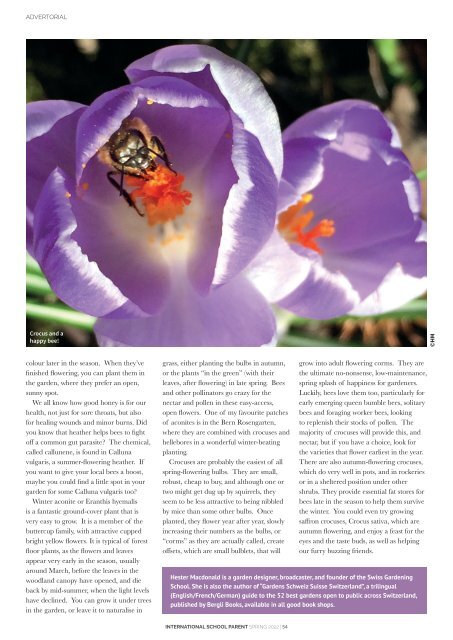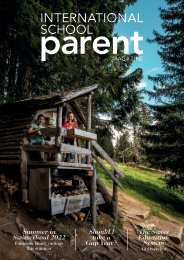International School Parent Magazine - Spring 2022
Create successful ePaper yourself
Turn your PDF publications into a flip-book with our unique Google optimized e-Paper software.
ADVERTORIAL<br />
Crocus and a<br />
happy bee!<br />
©HM<br />
colour later in the season. When they’ve<br />
finished flowering, you can plant them in<br />
the garden, where they prefer an open,<br />
sunny spot.<br />
We all know how good honey is for our<br />
health, not just for sore throats, but also<br />
for healing wounds and minor burns. Did<br />
you know that heather helps bees to fight<br />
off a common gut parasite? The chemical,<br />
called callunene, is found in Calluna<br />
vulgaris, a summer-flowering heather. If<br />
you want to give your local bees a boost,<br />
maybe you could find a little spot in your<br />
garden for some Calluna vulgaris too?<br />
Winter aconite or Eranthis hyemalis<br />
is a fantastic ground-cover plant that is<br />
very easy to grow. It is a member of the<br />
buttercup family, with attractive cupped<br />
bright yellow flowers. It is typical of forest<br />
floor plants, as the flowers and leaves<br />
appear very early in the season, usually<br />
around March, before the leaves in the<br />
woodland canopy have opened, and die<br />
back by mid-summer, when the light levels<br />
have declined. You can grow it under trees<br />
in the garden, or leave it to naturalise in<br />
grass, either planting the bulbs in autumn,<br />
or the plants “in the green” (with their<br />
leaves, after flowering) in late spring. Bees<br />
and other pollinators go crazy for the<br />
nectar and pollen in these easy-access,<br />
open flowers. One of my favourite patches<br />
of aconites is in the Bern Rosengarten,<br />
where they are combined with crocuses and<br />
hellebores in a wonderful winter-beating<br />
planting.<br />
Crocuses are probably the easiest of all<br />
spring-flowering bulbs. They are small,<br />
robust, cheap to buy, and although one or<br />
two might get dug up by squirrels, they<br />
seem to be less attractive to being nibbled<br />
by mice than some other bulbs. Once<br />
planted, they flower year after year, slowly<br />
increasing their numbers as the bulbs, or<br />
“corms” as they are actually called, create<br />
offsets, which are small bulblets, that will<br />
grow into adult flowering corms. They are<br />
the ultimate no-nonsense, low-maintenance,<br />
spring splash of happiness for gardeners.<br />
Luckily, bees love them too, particularly for<br />
early emerging queen bumble bees, solitary<br />
bees and foraging worker bees, looking<br />
to replenish their stocks of pollen. The<br />
majority of crocuses will provide this, and<br />
nectar, but if you have a choice, look for<br />
the varieties that flower earliest in the year.<br />
There are also autumn-flowering crocuses,<br />
which do very well in pots, and in rockeries<br />
or in a sheltered position under other<br />
shrubs. They provide essential fat stores for<br />
bees late in the season to help them survive<br />
the winter. You could even try growing<br />
saffron crocuses, Crocus sativa, which are<br />
autumn flowering, and enjoy a feast for the<br />
eyes and the taste buds, as well as helping<br />
our furry buzzing friends.<br />
Hester Macdonald is a garden designer, broadcaster, and founder of the Swiss Gardening<br />
<strong>School</strong>. She is also the author of “Gardens Schweiz Suisse Switzerland”, a trilingual<br />
(English/French/German) guide to the 52 best gardens open to public across Switzerland,<br />
published by Bergli Books, available in all good book shops.<br />
INTERNATIONAL SCHOOL PARENT SPRING <strong>2022</strong> | 54














